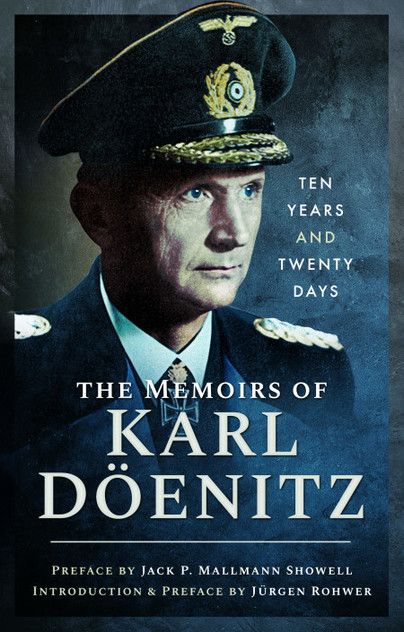| Title: | Ten Years and Twenty Days - The memoirs of Karl Döenitz |
| Writer: | Dönitz, K. |
| Published: | Frontline Books |
| Published in: | 2020 |
| Pages: | 520 |
| Language: | English |
| ISBN: | 9781848326446 |
| Description: | Following the suicide of Adolf Hitler, Karl Dönitz became the Führer of the Third Reich. But how did he rise to that position? Why did Hitler name this man as his successor? During the First World War, Dönitz served in the submarine service. During the Second World War, he commanded all submarines in the German Navy, before becoming, for a few days, the leader of the Third Reich. After the war he was imprisoned by the Allies, before being sentenced at the Nuremberg trials, and spent ten years in prison. There, he wrote his autobiography, which is based on his experiences and his view of submarine warfare during the Second World War. During the Second World War, German U-boats were feared by Allied sailors. The cause of the crews' fear was that German submarines could appear close by and undetected before disappearing again. This fear diminished over time, however, as the submarines were from a certain point no longer hunters, but the hunted. However, despite all the setbacks, Dönitz continued to fight until the end. On a technical level, the book is well written. Dönitz has broad knowledge of the subject, and carried out research on the logbooks and conditions of his submarine crews. In this he was helped by, amongst others, his son-in-law, who also served with the submarine service. Despite the factual approach, the book also has an ideological message, owing to the years that Dönitz spent in prison. As a result of his incarceration, he was less influenced by the denazification of Germany, because he was isolated from the rest of the world. Germany as a nation had meanwhile begun to look for tentative explanations for why it had behaved in the way it had. The book outlines a vision of how Dönitz wants himself and his men to be remembered after the Second World War, and much attention is paid to developments in the submarine service. However, Dönitz is not always completely frank. For example, he sometimes remains silent about certain matters and does not always ask difficult questions, leaving the interpretation to the reader. At times, the influence of the submarine service is overstated, but that is partly due to the position he held. The reasons for fighting until the end are extensively explained. The translation is pleasant to read, and Dönitz comes across as someone who has carried out a careful examination of his experiences. The foreword by Jak Mallmann Showell, an author of several books about the Kriegsmarine (German Imperial Navy), is noteworthy for Showell’s attempt to assert that the history of WWII is a giant conspiracy. According to him, an advantage of the book is that it was written so soon after the war that no post-war lies were incorporated into it. Showell asserts that all kinds of fictional accounts – for which there was supposedly no evidence – were used in the Numerberg trials where Dönitz was sentenced (see: Verdict Dönitz). According to Showell, historians then took these narrative accounts, rearranged them, and supplemented them with their own fantasies, as if it wasn't all contrived by the Allies as anti-German propaganda. This book is absolutely essential for anyone who wants to deepen their knowledge of the submarine war. From his position, Dönitz had enormous influence on the development, personnel, and structure of the war, both above and below water. The choices he made had far-reaching consequences. The technological developments on the German side are well explained and give insight into the many adversities with which the men had to cope. It is important to bear in mind that the portrayal of events is not completely accurate, but rather reflects how Dönitz wants the narrative to be interpreted by others. |
| Rating: |     Very good Very good |
Information
- Translated by:
- Tomas Brogan
- Article by:
- Samuel de Korte
- Published on:
- 04-10-2020
- Feedback?
- Send it!




